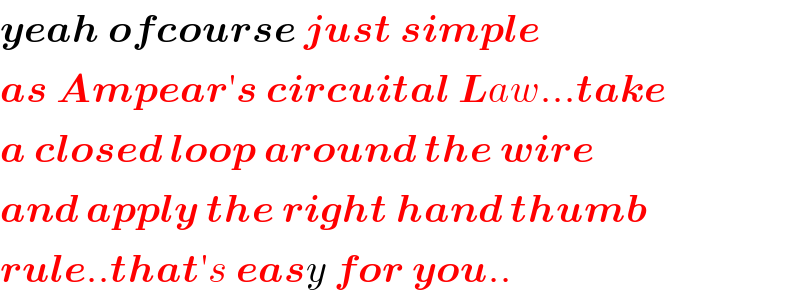Question Number 99905 by Rio Michael last updated on 23/Jun/20

Commented by Rio Michael last updated on 23/Jun/20

$$\mathrm{P}\:\mathrm{and}\:{Q}\:\mathrm{are}\:\mathrm{two}\:\mathrm{identical}\:\mathrm{straight}\:\mathrm{cables}\:\mathrm{each}\:\mathrm{of}\:\mathrm{electrical}\:\mathrm{resistance}\:\mathrm{20}.\mathrm{0}\Omega. \\ $$$$\mathrm{placed}\:\mathrm{4}.\mathrm{8}\:\mathrm{cm}\:\mathrm{apart}\:\mathrm{in}\:\mathrm{air}.\: \\ $$$$\left(\mathrm{a}\right)\:\mathrm{find}\:\mathrm{the}\:\mathrm{current}\:\mathrm{through}\:\mathrm{each}\:\mathrm{cable} \\ $$$$\left(\mathrm{b}\right)\:\mathrm{draw}\:\mathrm{the}\:\mathrm{magnetic}\:\mathrm{field}\:\mathrm{pattern}\:\mathrm{in}\:\mathrm{the}\:\mathrm{region}\:\mathrm{between}\:{P}\:\mathrm{and}\:{Q} \\ $$$$\left(\mathrm{c}\right)\:\mathrm{determine}\:\mathrm{the}\:\mathrm{resultant}\:\mathrm{magnetic}\:\mathrm{flux}\:\mathrm{density}\:\mathrm{at}\:\mathrm{the}\:\mathrm{point}\:{R}\:\mathrm{due}\:\mathrm{to} \\ $$$$\mathrm{P}\:\mathrm{and}\:{Q}\:\mathrm{only}. \\ $$
Commented by smridha last updated on 24/Jun/20
![current through each cables I=((12)/(20))=0.6A(parallel combination) the direcrion of current flow through the each conductor(p and q) is same so the resultant mangnetic flux density is at R is B=[((𝛍_0 I)/(2𝛑(1.8×10^(−2) )))+((𝛍_0 I)/(2𝛑(3×10^(−2) )))]T =((4𝛑×10^(−7) ×0.6×4.8×10^(−2) )/(2𝛑×5.4×10^(−4) )) =1.0666×10^(−5) T](https://www.tinkutara.com/question/Q99956.png)
$$\boldsymbol{{current}}\:\boldsymbol{{through}}\:\boldsymbol{{each}}\:\boldsymbol{{cables}} \\ $$$$\boldsymbol{{I}}=\frac{\mathrm{12}}{\mathrm{20}}=\mathrm{0}.\mathrm{6}{A}\left({parall}\boldsymbol{{el}}\:\boldsymbol{{combination}}\right) \\ $$$$\boldsymbol{{the}}\:\boldsymbol{{direcrion}}\:\boldsymbol{{of}}\:\boldsymbol{{current}}\:\boldsymbol{{flow}} \\ $$$$\boldsymbol{{through}}\:\boldsymbol{{the}}\:\boldsymbol{{each}}\:\boldsymbol{{conductor}}\left(\boldsymbol{{p}}\:\boldsymbol{{and}}\:\boldsymbol{{q}}\right) \\ $$$$\boldsymbol{{is}}\:\boldsymbol{{same}}\:\boldsymbol{{so}}\:\boldsymbol{{the}}\:\boldsymbol{{resultant}}\:\boldsymbol{{mangnetic}} \\ $$$$\boldsymbol{{flux}}\:\boldsymbol{{density}}\:\boldsymbol{{is}}\:\boldsymbol{{at}}\:\boldsymbol{{R}}\:{is} \\ $$$$\:\:\boldsymbol{{B}}=\left[\frac{\boldsymbol{\mu}_{\mathrm{0}} \boldsymbol{{I}}}{\mathrm{2}\boldsymbol{\pi}\left(\mathrm{1}.\mathrm{8}×\mathrm{10}^{−\mathrm{2}} \right)}+\frac{\boldsymbol{\mu}_{\mathrm{0}} \boldsymbol{{I}}}{\mathrm{2}\boldsymbol{\pi}\left(\mathrm{3}×\mathrm{10}^{−\mathrm{2}} \right)}\right]\boldsymbol{{T}} \\ $$$$\:\:\:\:\:=\frac{\mathrm{4}\boldsymbol{\pi}×\mathrm{10}^{−\mathrm{7}} ×\mathrm{0}.\mathrm{6}×\mathrm{4}.\mathrm{8}×\mathrm{10}^{−\mathrm{2}} }{\mathrm{2}\boldsymbol{\pi}×\mathrm{5}.\mathrm{4}×\mathrm{10}^{−\mathrm{4}} } \\ $$$$=\mathrm{1}.\mathrm{0666}×\mathrm{10}^{−\mathrm{5}} \boldsymbol{{T}} \\ $$$$ \\ $$
Commented by Rio Michael last updated on 24/Jun/20

$$\mathrm{Brilliant}\:\mathrm{sir}..\mathrm{thank}\:\mathrm{you}.\:\mathrm{sir}\:\mathrm{if} \\ $$$$\mathrm{i}'\mathrm{m}\:\mathrm{to}\:\mathrm{draw}\:\mathrm{the}\:\mathrm{magnetic}\:\mathrm{pattern} \\ $$$$\mathrm{will}\:\mathrm{it}\:\mathrm{be}\:\mathrm{like}\:\mathrm{this}? \\ $$$$\:\:\circlearrowleft\:\:\:\:\:\:\:\circlearrowleft \\ $$
Commented by smridha last updated on 24/Jun/20

$$\boldsymbol{{yeah}}\:\boldsymbol{{ofcourse}}\:\boldsymbol{{just}}\:\boldsymbol{{simple}} \\ $$$$\boldsymbol{{as}}\:\boldsymbol{{Ampear}}'\boldsymbol{{s}}\:\boldsymbol{{circuital}}\:\boldsymbol{{L}}{aw}…\boldsymbol{{take}} \\ $$$$\boldsymbol{{a}}\:\boldsymbol{{closed}}\:\boldsymbol{{loop}}\:\boldsymbol{{around}}\:\boldsymbol{{the}}\:\boldsymbol{{wire}} \\ $$$$\boldsymbol{{and}}\:\boldsymbol{{apply}}\:\boldsymbol{{the}}\:\boldsymbol{{right}}\:\boldsymbol{{hand}}\:\boldsymbol{{thumb}} \\ $$$$\boldsymbol{{rule}}..\boldsymbol{{that}}'{s}\:\boldsymbol{{eas}}{y}\:\boldsymbol{{for}}\:\boldsymbol{{you}}.. \\ $$
Commented by Rio Michael last updated on 24/Jun/20

$$\mathrm{thanks}\:\mathrm{sir}\:\mathrm{for}\:\mathrm{the}\:\mathrm{explanations} \\ $$
